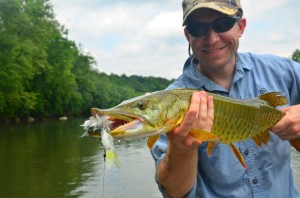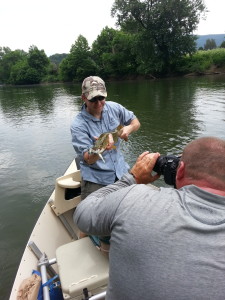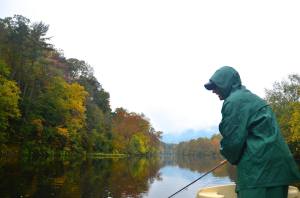I’ve long known about the musky populations in Virginia rivers such as the New, James, and Shenandoah. Going after them has always been a fleeting thought in my head, but never made an honest effort to try to catch one. That all changed after a post on the message board of my local fly fishing club, Tidal Potomac Fly Rodders, with a picture of one of these beast’s toothy grin caught on a trip with Matt Miles – who I’ve dubbed the King of Musky Fly Fishing – of Matt Miles Fly Fishing. The wheels started turning. At a Tidal Potomac “Beer Tie” (a beer tie is an excuse for a bunch of guys to drink beer while tying flies and trading fish stories and lies), I met Joe and the musky idea came up. It was all but a done deal after that, and we were on our way to try to catch the fish of 10,000 casts.
Our first attempt at going out with Matt was postponed due to a massive rainstorm completely blowing out the James River. Early June brought around our second attempt. This time, a rain storm added a little bit of flow and quite a bit of color, but not too much to call it off for a second time. Our 6:30 AM meeting put us on the river around 7 AM. We’d be targeting musky, but throwing some smallmouth flies in between musky holes.
Matt likes to throw big flies for musky. I don’t mean “big” like 4 inch deceivers. I mean BIG. The flies look like they’re the product of a weird science project to combine a full size chicken and squirrel. We’re talking 10, 12, or even 14 inch flies. Throwing a wet sock is no easy task. Minimizing your false casts and double hauling is a requirement to having a chance of throwing this 11 weight all day.
Matt likes to throw big flies for musky. I don’t mean “big” like 4 inch deceivers. I mean BIG. The flies look like they’re the product of a weird science project to combine a full size chicken and squirrel. We’re talking 10, 12, or even 14 inch flies. Throwing a wet sock is no easy task. Minimizing your false casts and double hauling is a requirement to having a chance of throwing this 11 weight all day. If you learn to water-load, that will really help you late in the trip when you think your arm is about to fall off. My nice long casts from the early morning turned into mustering all my strength for a pitiful 30 foot cast by the last hole.
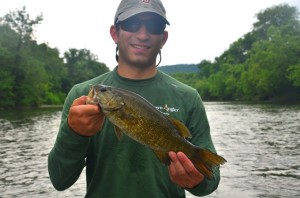 Our day started off pretty slow. There were no musky to be seen. No strikes, no follows, nothing. You shouldn’t expect to see one every cast or every hole, but we were just getting blanked completely. To top it off, we couldn’t even muster a strike or follow from a smallmouths between musky holes. We were starting to get suspicious if fish actually lived in the James at all. Matt changed up my fly to a Tequilly and that woke up the smallies. This section of the James is still recovering from a fish kill and a few poor spawns, so most of the smallmouth were pretty small. That was OK, though, because this river isn’t a place we would have gone to target the smallies. Even still, I ended up with a couple decent size fish that are an absolute blast on the fly rod. Joe wasn’t having quite the same luck and was quick to blame me for stealing all the good holes from the front of the drift boat.
Our day started off pretty slow. There were no musky to be seen. No strikes, no follows, nothing. You shouldn’t expect to see one every cast or every hole, but we were just getting blanked completely. To top it off, we couldn’t even muster a strike or follow from a smallmouths between musky holes. We were starting to get suspicious if fish actually lived in the James at all. Matt changed up my fly to a Tequilly and that woke up the smallies. This section of the James is still recovering from a fish kill and a few poor spawns, so most of the smallmouth were pretty small. That was OK, though, because this river isn’t a place we would have gone to target the smallies. Even still, I ended up with a couple decent size fish that are an absolute blast on the fly rod. Joe wasn’t having quite the same luck and was quick to blame me for stealing all the good holes from the front of the drift boat.
We stopped for a stream-side picnic lunch before picking back up to try to find that elusive Musky. Joe took over the front of the boat (no more excuses from him now!) and we started slinging our water-logged birds. We approached a hole that Matt said was ripe with potential. Joe just about had his fly in the boat when I hear “MUSKY!!!!” and see Joe’s rod doubled over with an angry torpedo taking flight. It must have been his 10,000th cast.
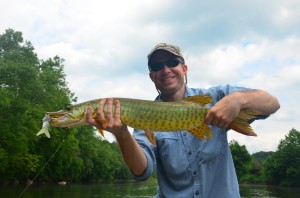 The musky tried its best to escape, but was no match for the 11 wt Helios 2. Joe subdued the fish and Matt scooped it up. It was officially the first Musky either of us had ever caught, and the first one I had even seen in person. At about 33 inches, it wasn’t the biggest fish in the river, but was no baby either. Matt whipped out his camera and snapped a few pictures. As you can tell from the photos, Matt definitely has some photography skills as well as fishing skills. Matt got the fish back in the water and release him to fight another day.
The musky tried its best to escape, but was no match for the 11 wt Helios 2. Joe subdued the fish and Matt scooped it up. It was officially the first Musky either of us had ever caught, and the first one I had even seen in person. At about 33 inches, it wasn’t the biggest fish in the river, but was no baby either. Matt whipped out his camera and snapped a few pictures. As you can tell from the photos, Matt definitely has some photography skills as well as fishing skills. Matt got the fish back in the water and release him to fight another day.
About 10 minutes later, we pull up to another hole. Matt points out some fishy water, and Joe tosses his fly towards the spot. BOOM! An enormous musky hits his fly. This fish had to have been at least 50 inches. Unfortunately, the hook point didn’t find its way home and the best view we got was the flash of the fish. Joe and I each got one more follow, but couldn’t coax either fish to eat. By the end of our long day, Joe and I were both exhausted. I’ve never wanted to stop fishing before – and this wasn’t didn’t become the first time – but I just could make another cast to save my life.
For a unique fly fishing experience, be sure to call up Matt. Central and Southwest Virginia has some fantastic fishing, and this definitely needs to be on your bucket list. Matt guides year round for smallmouth and trout, and recommends September through June for Musky. I’m already starting to make plans to get back out there with him this fall. Rates start at $275 for a half day and $375 for a full day. Book a trip with Matt and come back and leave a review! Check out a short GoPro-filmed version of the trip on YouTube.
